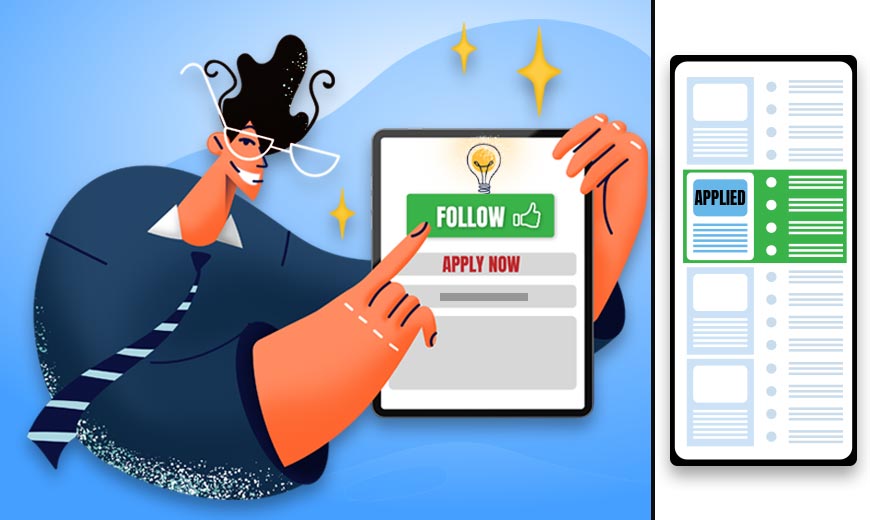Employer Branding: A Guide to Company’s Social Media Success
Introduction
Ever feel lost in the repetitive humdrum of job searches, where every company’s pitch seems like a deja vu of the last? Imagine scrolling through a company’s social media and realizing it’s not just about jobs; it’s about people—real, relatable, and refreshingly unfiltered. If you’ve ever wondered why some employers make you hit ‘Follow’ before ‘Apply,’ you’re not alone. In this blog, we decode this enchanting narrative, where employer branding transforms into a storytelling adventure. Welcome to a world where careers unfold like chapters waiting to be written.
Understanding the Significance of Employer Branding
In the realm of talent acquisition and employee retention, the concept of employer branding holds immense significance. It goes beyond just a catchy tagline or an attractive logo; it encapsulates the essence of what it’s like to work for your organization. A strong employer brand serves as a magnetic force, drawing in top-tier talent, fostering employee loyalty, and ultimately contributing to the overall success of your company.
- Attracting Top Talent: Research consistently shows that job seekers actively seek out information about a company’s employer brand before applying for a position. A compelling employer brand can be the key differentiator that attracts the best candidates in a competitive job market.
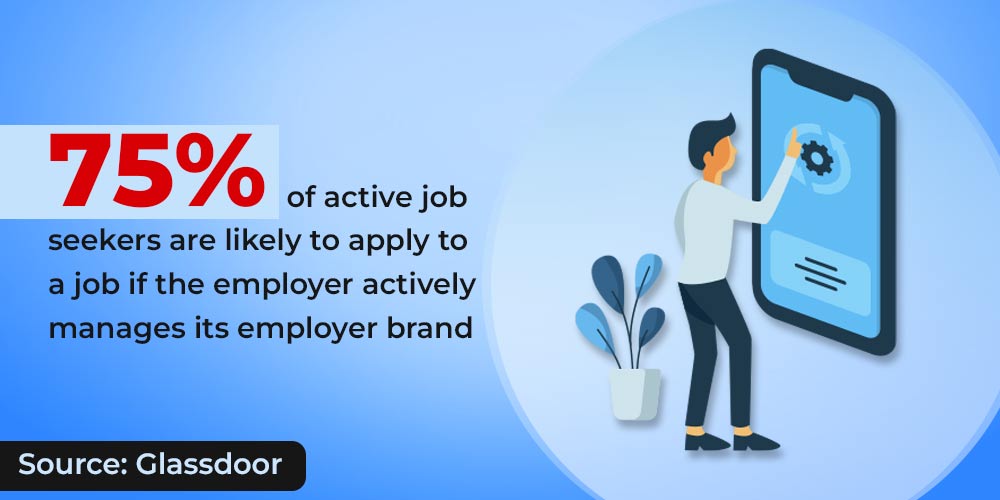

- Employee Retention and Satisfaction: Employer branding isn’t just about attracting new talent; it’s equally crucial for retaining existing employees. A well-defined employer brand contributes to a positive work environment, fostering employee satisfaction and reducing turnover.
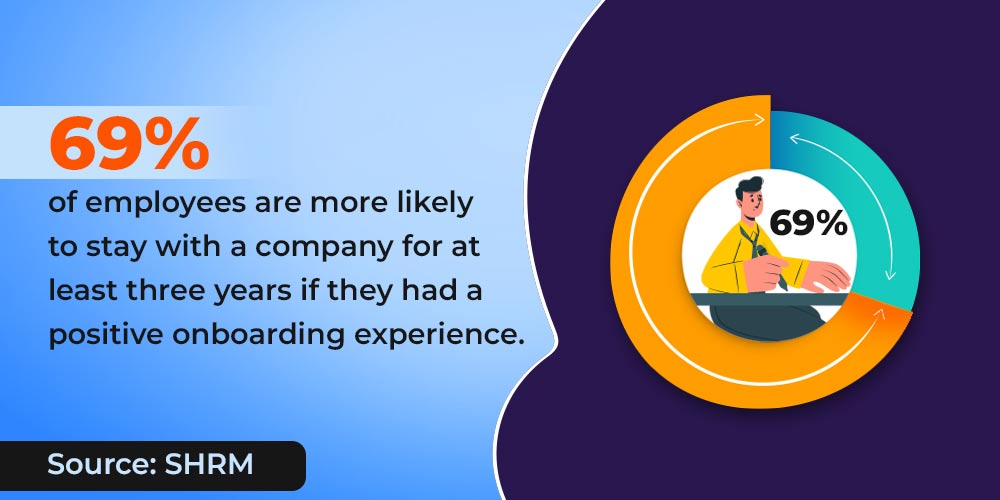

- Business Reputation and Consumer Perception: Your employer brand isn’t confined to the internal workings of your organization. It also has a direct impact on how your company is perceived by clients, customers, and the general public. A strong employer brand enhances your business reputation, instills confidence in consumers, and can even positively influence purchasing decisions.
The Role of Social Media in Shaping Employer Brand Perception
The advent of social media has revolutionized the way companies approach employer branding. No longer confined to traditional channels, social media provides a dynamic platform for organizations to showcase their culture, values, and day-to-day operations. It acts as a window into the soul of your company, allowing potential candidates to gauge whether they align with your ethos.
- Real-Time Communication: Social media platforms offer real-time communication, allowing organizations to share updates, news, and achievements instantaneously. This transparency is invaluable in shaping the perception of your employer brand.
- Employee Advocacy and Engagement: Social media facilitates employee advocacy, turning your workforce into brand ambassadors. When employees actively share their experiences and achievements on platforms like LinkedIn, Twitter, or Instagram, it humanizes the organization and adds authenticity to the employer brand.
- Showcasing Company Culture: Through multimedia content such as photos, videos, and stories, social media allows organizations to showcase their unique company culture. A well-crafted Instagram post or a LinkedIn video can provide a glimpse into the day-to-day life at your company, giving potential candidates a tangible sense of what it’s like to work there.
Research and Analysis
Before embarking on your employer brand journey, it’s crucial to conduct a comprehensive analysis. Identify your unique selling points and understand the pulse of your current workforce through employee surveys.
Identifying Your Employer Value Proposition (EVP)
In the fiercely competitive job market, attracting and retaining top talent requires more than just a job listing. It demands a clear and compelling Employer Value Proposition (EVP), a unique set of offerings that distinguishes your organization as an employer of choice. Here’s a detailed exploration of the crucial steps in identifying and refining your EVP:
Analyzing Company Culture and Values:
Your company culture and values form the bedrock of your EVP. They define the working environment, the relationships among colleagues, and the collective purpose that drives your organization. Analyzing these aspects is critical to understanding what makes your workplace unique.
Key Actions:
- Conduct in-depth interviews with current employees to uncover their perceptions of the company culture.
- Evaluate existing company values and assess how well they align with the day-to-day experiences of employees.
- Look for distinctive cultural elements that set your organization apart – be it a commitment to innovation, inclusivity, or a focus on work-life balance.
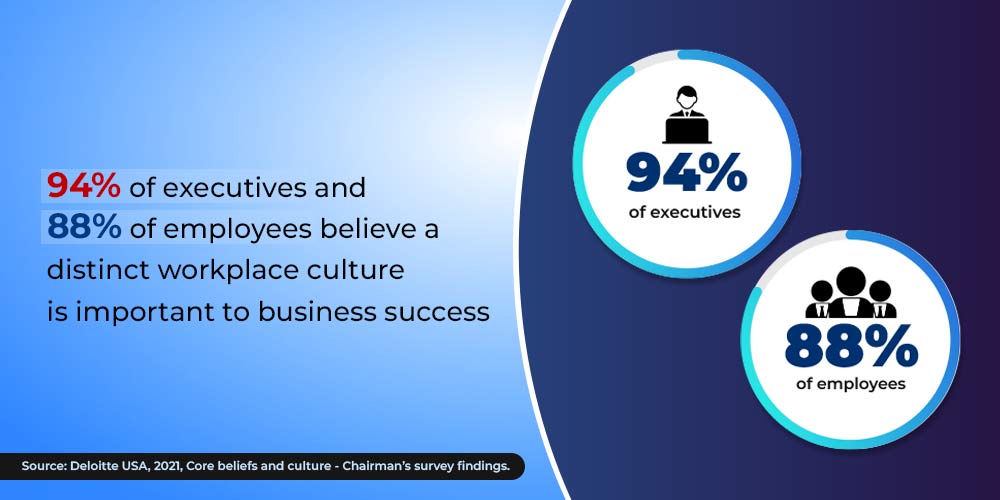

Employee Surveys and Feedback:
Your employees are the best source of insights into the strengths and weaknesses of your organization as an employer. Employee surveys and feedback mechanisms provide valuable data to shape and refine your EVP, ensuring that it resonates with the actual experiences of your workforce.
Key Actions:
- Conduct anonymous employee surveys covering aspects such as job satisfaction, work-life balance, career development opportunities, and overall engagement.
- Analyze feedback trends to identify recurring themes and areas for improvement.
- Use focus groups or one-on-one interviews to delve deeper into specific aspects of the employee experience.
A study found that 60% of job seekers would not apply to a company with a 1-star rating (on a 5-point scale). This suggests that many job seekers do seem to use workplace review sites, and negative reviews can dissuade them from applying to a particular company.
By merging insights from both the analysis of company culture and values, and employee surveys and feedback, organizations can create a nuanced and authentic EVP. This EVP becomes the cornerstone for attracting top talent, fostering employee satisfaction, and ultimately building a workplace that stands out in the competitive landscape.
Competitive Analysis
In the dynamic world of talent acquisition, understanding your competitors’ employer brands is pivotal to crafting a distinctive and appealing Employee Value Proposition (EVP). A comprehensive competitive analysis involves evaluating their strategies, strengths, and weaknesses. Here’s a detailed guide to conducting an effective competitive analysis:
Evaluating Competitors’ Employer Brands:
Analyzing competitors’ employer brands provides crucial insights into industry benchmarks, trends, and potential gaps in your strategy. It helps you understand how your organization compares in terms of employer attractiveness, allowing you to identify areas for improvement or differentiation.
Key Actions:
- Identify key competitors in your industry or niche.
- Analyze their online presence, including their careers pages, social media profiles, and employee reviews on platforms like Glassdoor.
- Look for common themes, strengths, and weaknesses in how competitors present their employer brand.
Identifying Unique Selling Points:
To stand out in a competitive job market, your organization needs to identify and leverage its unique selling points. These are the aspects of your employer brand that set you apart and make your workplace an appealing choice for potential candidates.
Key Actions:
- Conduct internal assessments to identify strengths and differentiators. This could include a diverse and inclusive culture, innovative work projects, or unique benefits and perks.
- Compare these internal strengths with the weaknesses or gaps identified in competitors’ employer brands.
- Develop a clear understanding of what makes your organization a compelling choice for candidates that is distinct from competitors.
This strategic approach ensures that your EVP is not only competitive but also stands out in the eyes of top talent, attracting candidates who resonate with what makes your workplace unique.
Define Target Audience
Crafting an employer brand that resonates requires a deep understanding of your audience. Creating detailed personas for ideal candidates is a strategic step that goes beyond traditional recruitment, incorporating demographics, psychographics, and career aspirations.
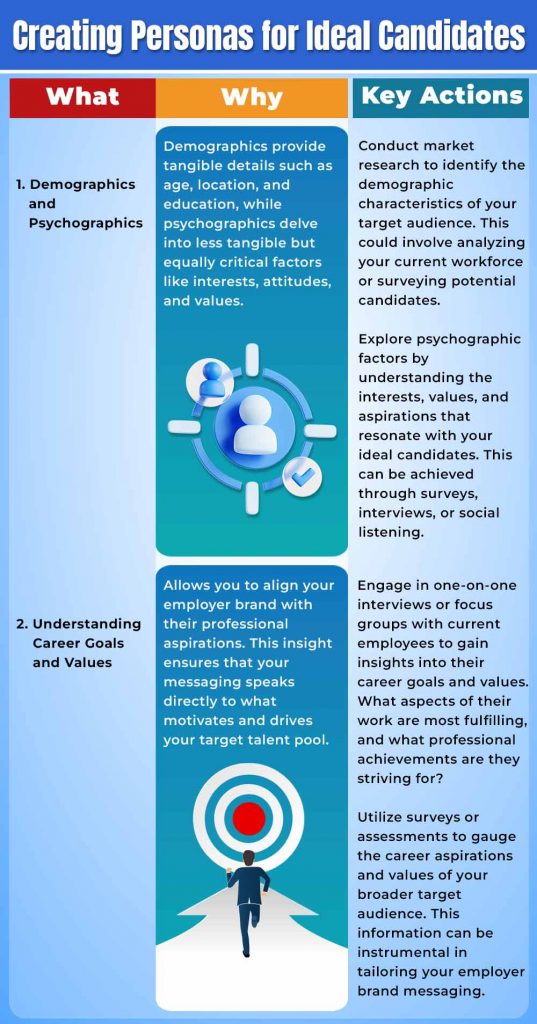

These personas serve as the foundation for a nuanced and resonant employer brand strategy, effectively communicating why your organization is the ideal workplace for those who share these characteristics.
Establish Brand Consistency
Consistency is key when it comes to employer branding. A study by Weber Shandwick found that 84% of consumers believe that a brand’s consistency across platforms is as important as its products and services. Align your employer brand with the corporate brand, ensuring a seamless and coherent narrative.
Crafting a Compelling Employer Brand Story
In the competitive landscape of employer branding, storytelling is a powerful tool that can humanize your organization and resonate with potential candidates. Crafting a compelling employer brand story involves aligning it with your corporate branding and ensuring consistency across various platforms. Here’s a detailed guide on this integral aspect of employer branding:
Aligning with Corporate Branding:
Your employer brand story should seamlessly align with your corporate brand. Consistency in messaging, tone, and values reinforces a cohesive identity, making your organization instantly recognizable and reinforcing a sense of trust among potential candidates.
Key Actions:
- Collaborate closely with your marketing and branding teams to understand the core elements of your corporate brand, such as mission, vision, and values.
- Infuse these elements into your employer brand story, ensuring a natural alignment that reflects the overall identity of the organization.
- Use consistent visual elements, such as color schemes and logos, to reinforce the connection between your corporate and employer brand.
Ensuring Consistency Across Platforms:
Consistency is key when it comes to employer branding. Whether a candidate encounters your brand on LinkedIn, Instagram, or your company website, maintaining a consistent narrative and visual identity fosters recognition and trust.
Key Actions:
- Develop a style guide that outlines the preferred tone, language, and visual elements for your employer brand. Ensure this guide is accessible to all teams involved in creating content.
- Regularly audit your online presence to ensure that messaging across platforms is cohesive and aligned with your employer brand story.
- Encourage cross-functional collaboration to maintain consistency, involving HR, marketing, and any other relevant departments.
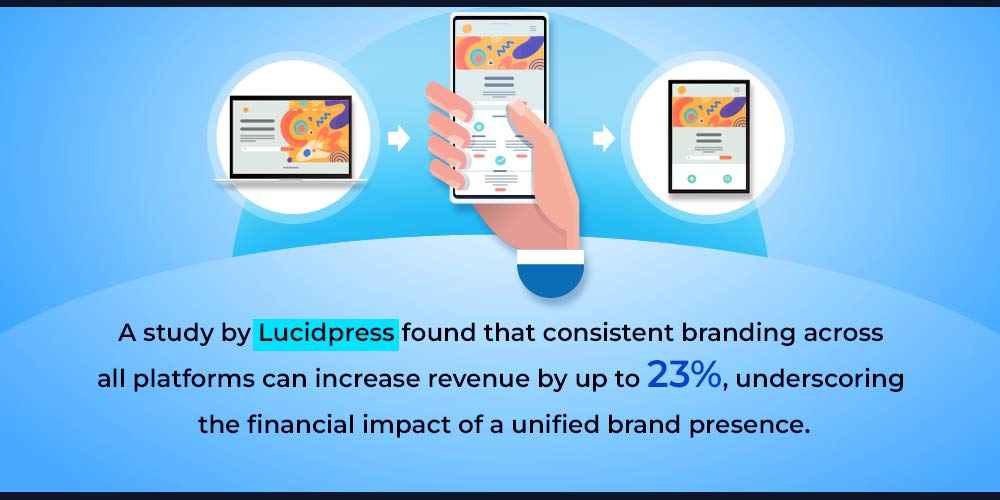

By aligning your employer brand story with corporate branding and ensuring consistency across platforms, you create a narrative that resonates with potential candidates. This cohesive approach not only reinforces your organization’s identity but also builds trust and credibility, making your employer brand more compelling in the eyes of top talent.
Designing a Striking Visual Identity
In the digital age, a visually compelling identity is instrumental in making a lasting impression and conveying the essence of your employer brand. Designing a striking visual identity involves careful consideration of elements such as logos, color palettes, and visual elements. Ensuring consistent branding in social media graphics further enhances brand recognition and reinforces a cohesive image. Here’s a detailed guide on crafting a visually compelling employer brand:
Logo, Color Palette, and Visual Elements:
Your logo, color palette, and visual elements serve as the visual foundation of your employer brand. They are the first things that potential candidates notice and can significantly influence how your organization is perceived. Consistency in these elements builds a strong and memorable visual identity.
Key Actions:
- Develop a distinctive and versatile logo that encapsulates your organization’s values and personality. Ensure it aligns with your corporate brand but is tailored to reflect the employer brand specifically.
- Choose a cohesive color palette that complements your corporate branding while evoking the desired emotions. Consistency in colors enhances brand recognition.
- Establish visual elements that represent your employer brand. This could include unique graphics, icons, or imagery that resonate with your target audience.
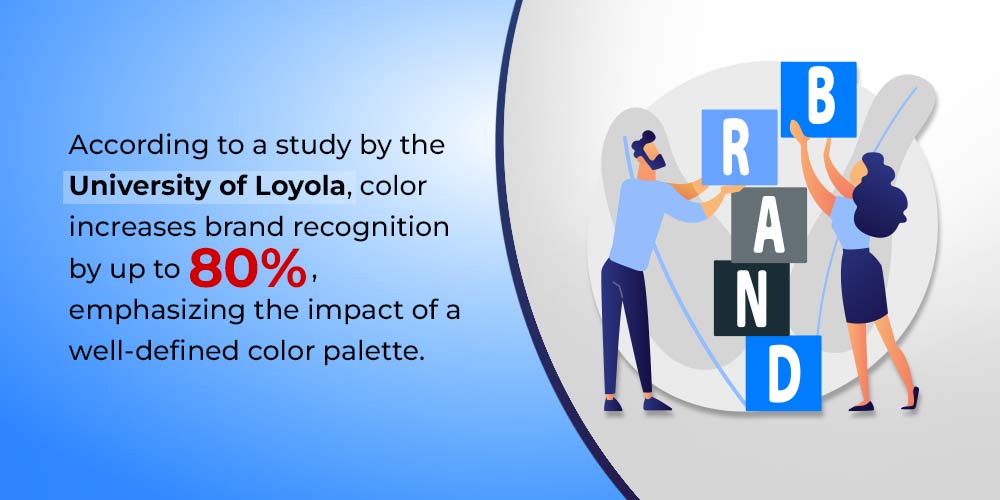

Consistent Branding in Social Media Graphics:
Social media is a dynamic platform where first impressions are often visual. Consistent branding in social media graphics ensures that your employer brand is instantly recognizable across various channels, reinforcing your identity and making a memorable impact.
Key Actions:
- Create social media graphics that align with your established visual identity. Incorporate the logo, color palette, and visual elements consistently across all graphics.
- Use templates or design guidelines to maintain uniformity in social media posts, ensuring a cohesive look and feel.
- Regularly update graphics to align with any changes or updates to your visual identity, keeping your employer brand fresh and relevant.
By focusing on elements such as logos, color palettes, and visual elements, and ensuring consistent branding in social media graphics, you not only enhance brand recognition but also create a visually compelling narrative that resonates with potential candidates. This visual identity becomes a powerful tool in conveying your employer brand story and making a lasting impression in the competitive talent market.
Choose Appropriate Social Media Platforms
Not all social media platforms are created equal. Understanding the demographics of various social media platforms is essential for effective employer branding. Researching platform demographics allows you to tailor your content and engagement strategies to match the characteristics of your target audience.
Each social media platform has its strengths and nuances. Identifying the key social media channels for your employer branding efforts allows you to concentrate resources where they will yield the highest engagement and impact.
It’s about selecting platforms that align with your target audience and organizational goals. By conducting thorough research on platform demographics, matching your target audience with platform users, and identifying key social media channels, you can optimize your employer branding efforts.
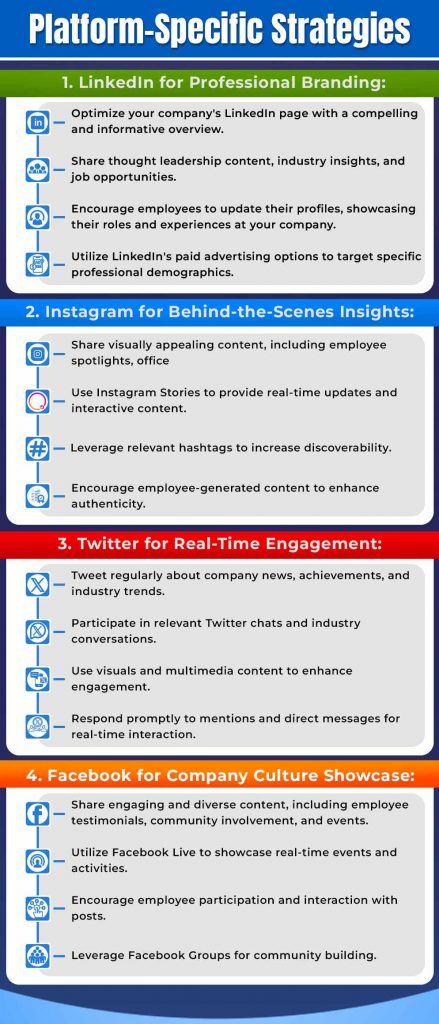

Content Strategy
Engaging content is the lifeblood of your employer brand. Share employee success stories, behind-the-scenes glimpses, and company achievements to create a compelling narrative. By incorporating infographics, visual quotes, video content, and employee testimonials into your employer branding strategy, you create a multi-dimensional narrative that resonates with your target audience. This visually rich approach enhances engagement, strengthens your employer brand, and sets you apart in the competitive talent market.
Engaging and Informative Content Creation
Creating compelling and informative content is pivotal in capturing the attention of potential candidates and showcasing your employer brand in the best light.
Here’s a detailed guide on crafting engaging content, specifically focusing on employee success stories, behind-the-scenes sneak peeks, and company achievements and milestones:
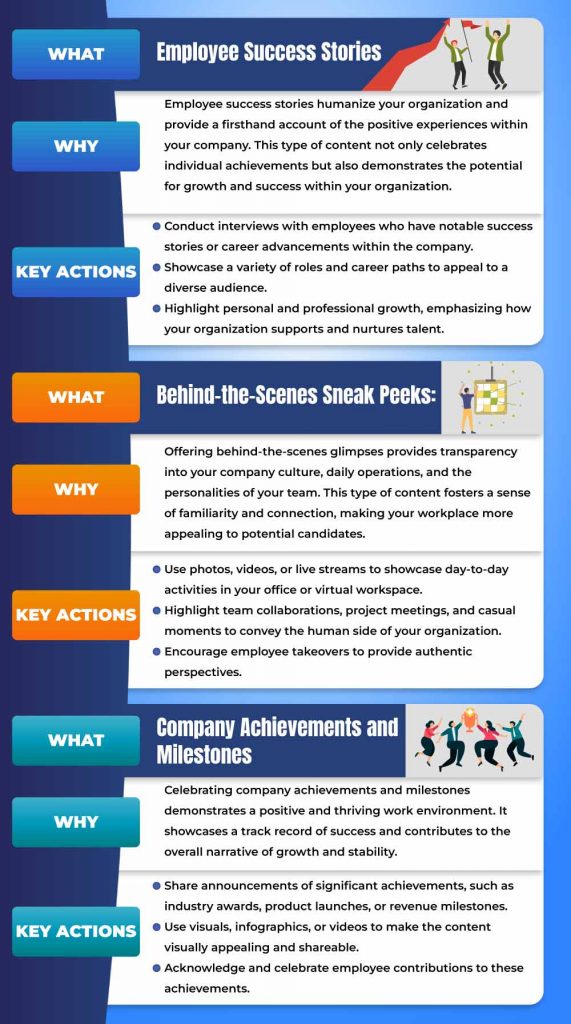

Utilizing Visual and Multimedia Content
Visual and multimedia content plays a crucial role in capturing attention and conveying messages more effectively. Visual content is 40 times more likely to get shared on social media than other types of content. Leveraging elements like infographics, visual quotes, video content, and employee testimonials enhances the richness of your employer branding efforts.
Here’s a comprehensive guide on how to effectively utilize visual and multimedia content:
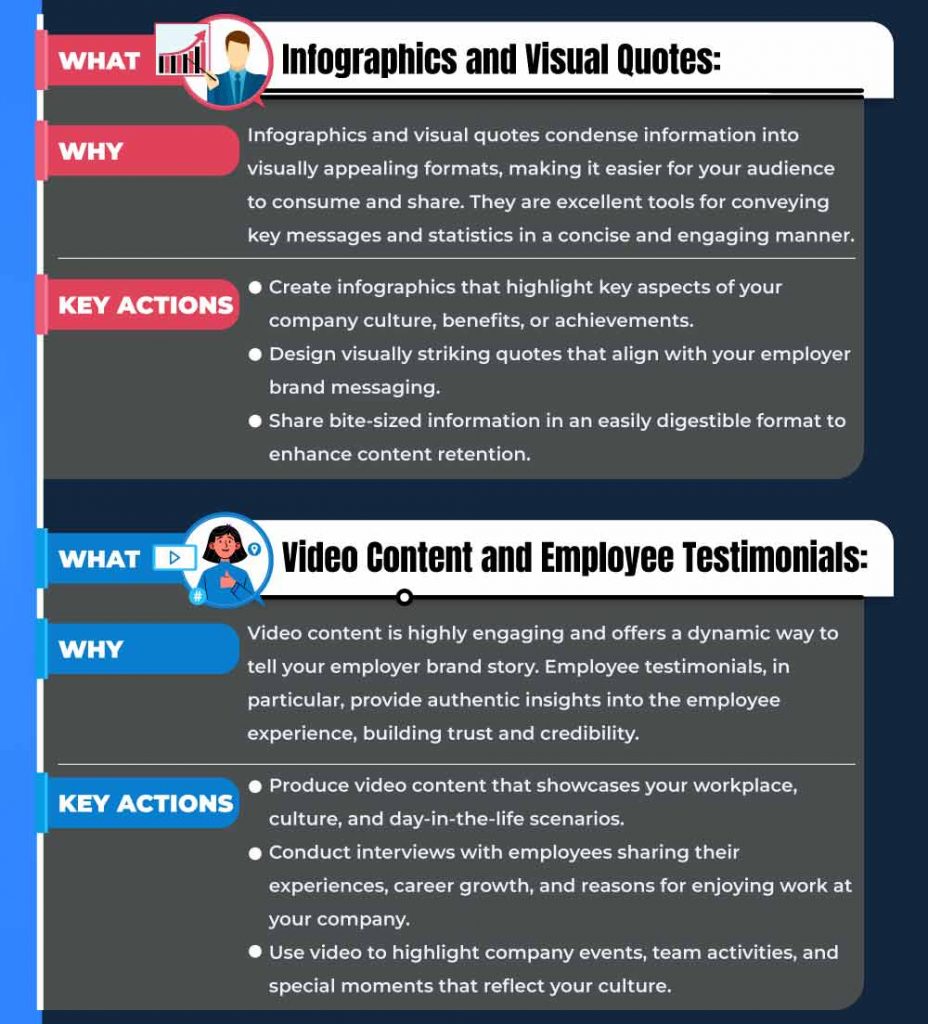

Best Practices for Utilizing Visual and Multimedia Content:
- Consistent Branding: Maintain a consistent visual identity across all multimedia content to reinforce your employer brand.
- Accessibility: Ensure that visual content is accessible to a diverse audience, considering factors like color contrast and subtitles in videos.
- Engagement: Encourage audience interaction by incorporating calls-to-action, such as asking for comments, shares, or responses to visual content.
- Authenticity: Emphasize authenticity in video content and testimonials to build trust with your audience.
- Storytelling: Use multimedia content to tell compelling stories about your company, employees, and achievements.
Employee Advocacy Programs
Harness the power of your greatest asset – your employees. Implement employee advocacy programs, encouraging staff to become brand ambassadors on social media.
Encouraging Employee Participation
Encouraging active participation from your employees is a powerful way to amplify your employer brand. Leveraging strategies such as employee takeovers on social media and promoting employee-generated content can create an authentic and engaging portrayal of your workplace culture.
- Employee Takeovers on Social Media: Employee takeovers provide a firsthand perspective of your company culture. Allowing employees to take control of social media accounts for a day or specific event adds authenticity and allows potential candidates to see the workplace through the eyes of those who experience it daily.
- Employee-Generated Content: Employee-generated content adds an authentic touch to your employer brand. It provides a diverse and personal perspective, showcasing the unique experiences and talents of your workforce.
Training Employees as Brand Ambassadors
Turning your employees into brand ambassadors involves equipping them with the tools and knowledge to represent your employer brand positively. This includes providing social media guidelines, and best practices, and recognizing and rewarding their advocacy efforts.
Social Media Guidelines and Best Practices:
Clear guidelines help employees understand how to represent the company on social media, ensuring a consistent and positive brand image. Best practices empower them to be effective brand advocates.
Key Actions:
- Develop comprehensive social media guidelines that outline expectations and permissible content.
- Provide training sessions or resources on best practices for representing the company online.
- Emphasize the importance of maintaining professionalism and confidentiality while sharing authentic experiences.
Recognizing and Rewarding Employee Advocacy:
Recognizing and rewarding employee advocacy not only acknowledges their efforts but also encourages continued engagement. It fosters a positive culture where employees feel valued and motivated to actively participate in employer branding.
By encouraging employee participation through takeovers, promoting employee-generated content, and training employees as brand ambassadors with clear guidelines and recognition programs, you not only amplify your employer brand but also foster a positive and engaged company culture.
Metrics and Analytics
To measure the impact of your efforts, establish key performance indicators (KPIs). A study by Hootsuite revealed that 73% of organizations track social media ROI through engagement metrics. Regularly review analytics, adjusting your strategies based on data insights to ensure continuous improvement.
Setting Key Performance Indicators (KPIs)
Establishing clear Key Performance Indicators (KPIs) is essential to measure the effectiveness of your employer branding efforts. Focus on social media engagement metrics and tracking employer brand perception to gauge the impact of your strategies.
Social Media Engagement Metrics:
Social media engagement metrics provide insights into how your audience interacts with your content. By measuring likes, shares, comments, and clicks, you can assess the level of engagement and identify what resonates with your audience.
Key KPIs:
- Likes and Shares: Measure the number of likes and shares to gauge the reach and popularity of your content.
- Comments: Assess the level of interaction and conversations sparked by your content.
- Click-Through Rate (CTR): Track the percentage of people who click on your content to explore further.
- Example Goal:
- Increase overall engagement by 20% in the next quarter.
Tracking Employer Brand Perception:
Monitoring employer brand perception helps you understand how your organization is perceived by potential candidates and current employees. This qualitative data provides insights into the effectiveness of your branding efforts.
Key KPIs:
- Surveys and Feedback: Use surveys to gather feedback on how your employer brand is perceived.
- Online Reviews: Monitor platforms like Glassdoor for employee reviews and sentiments.
- Brand Sentiment Analysis: Utilize tools to analyze online mentions and sentiment surrounding your employer brand.
- Example Goal:
- Achieve a 15% increase in positive sentiment regarding your employer brand within the next six months.
Regular Analytics Review and Adjustment
Regularly reviewing analytics data and adjusting your strategies based on insights is crucial for optimizing your employer branding efforts. This involves analyzing campaign performance and making strategic adjustments to enhance effectiveness.
Analyzing Campaign Performance:
Analyzing campaign performance provides valuable insights into what works and what needs improvement. By understanding which campaigns drive the most engagement and positive sentiment, you can refine your approach.
Key Actions:
- Evaluate the performance of individual campaigns using social media analytics tools.
- Identify high-performing content and elements that resonate with your audience.
- Assess the impact of campaigns on key KPIs, such as engagement and brand perception.
- Example Goal:
- Identify the most successful campaign elements and replicate them in future strategies.
Adjusting Strategies Based on Data Insights:
Data-driven insights guide strategic decisions. By adjusting your employer branding strategies based on analytics data, you can optimize your approach, allocate resources effectively, and ensure continuous improvement.
Key Actions:
- Identify patterns and trends in social media engagement and brand perception data.
- Adjust content themes, posting schedules, and platforms based on performance insights.
- Experiment with new approaches and content types to address areas that need improvement.
- Example Goal:
- Increase engagement on LinkedIn by 25% by adjusting posting frequency and content types based on analytics insights.
By setting clear KPIs, regularly reviewing analytics data, and adjusting strategies based on insights, you create a dynamic and responsive employer branding approach. This iterative process ensures continuous improvement and alignment with the evolving needs and preferences of your target audience.
Responding to Feedback
Feedback, both positive and negative, provides valuable insights. A report by Sprout Social found that 70% of consumers appreciate a brand’s response to their feedback. Monitor social media conversations diligently, addressing concerns promptly and showcasing your commitment to improvement.
Continuous Improvement
In the ever-evolving landscape of social media, staying ahead is crucial. According to a survey by Social Media Today, 76% of marketers consider staying updated with social media trends as important for their success. Embrace emerging platforms and consistently refine your employer brand strategies.
In conclusion, leveraging social media for employer branding is not just a strategy; it’s a necessity in today’s competitive job market. By following this holistic roadmap, backed by data and insights, you can establish a compelling employer brand that resonates with top talent and sets your organization apart. Remember, the journey to a stellar employer brand is ongoing, requiring adaptability and a commitment to continuous improvement.







